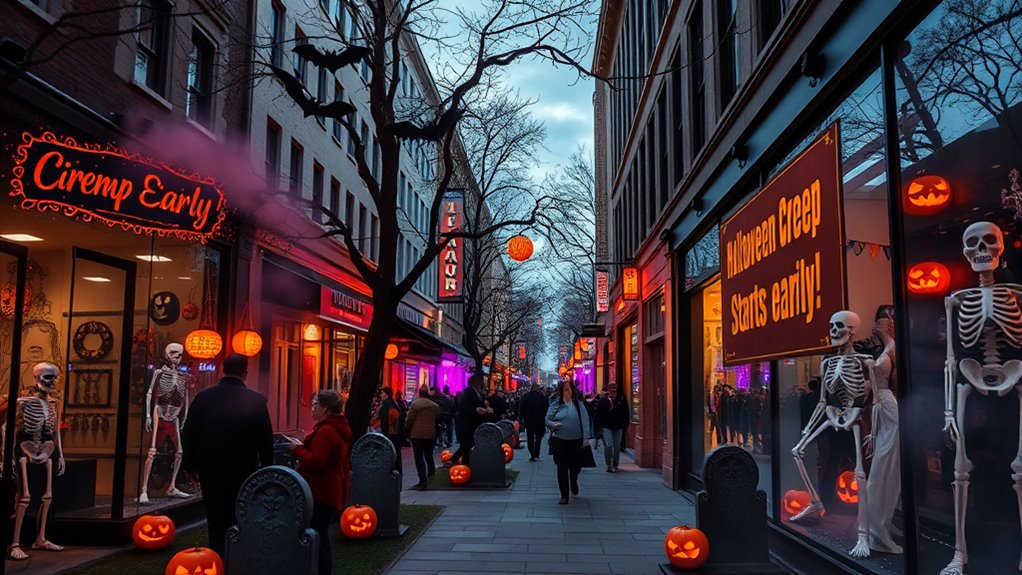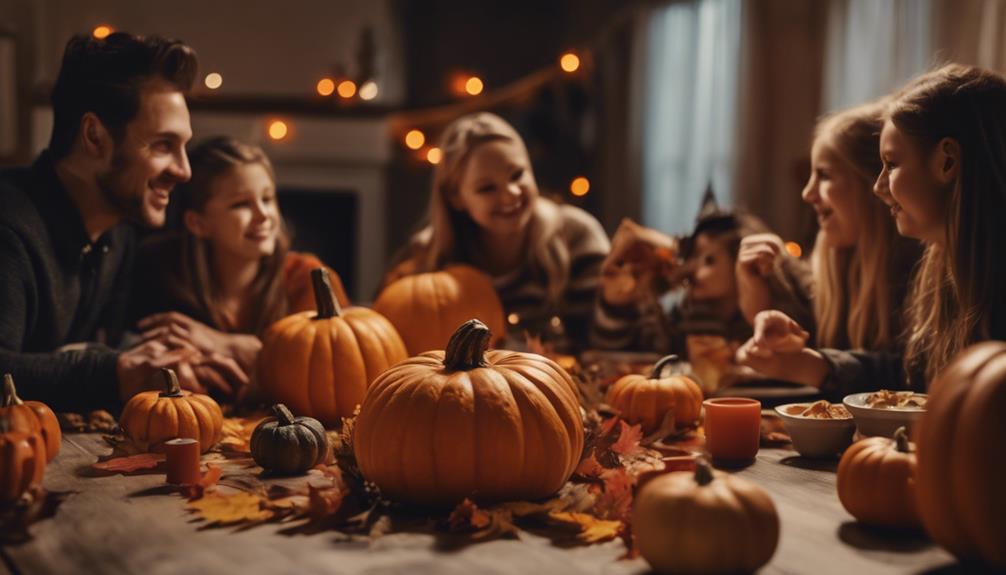You’ve probably noticed stores bringing out Halloween decorations and costumes earlier each year. Retailers do this to capture your attention sooner and boost sales by building excitement early. Starting in late summer or early fall, they showcase trending costumes and creative displays to influence your choices over a longer period. This extended season benefits everyone with more planning and fun ahead—if you keep exploring, you’ll discover how this trend is reshaping the Halloween experience.
Key Takeaways
- Halloween-related products and decorations appear as early as late summer, extending the season well before October.
- Retailers launch marketing campaigns and showcase trending costumes months in advance to boost sales.
- Stores introduce new costume trends as early as July or August, influencing consumer choices and planning.
- The early start enhances consumer anticipation, allowing more time for costume preparation and participation in events.
- Halloween creep reflects a strategic shift by retailers to maximize sales through prolonged marketing and product availability.

Have you noticed how Halloween’s spooky spirit seems to seep into everyday life earlier each year? “Halloween Creep” describes this rising phenomenon where holiday decorations, costumes, and marketing start appearing months before October 31st. It’s as if retailers and brands are racing to grab your attention long before the leaves turn and the air cools. This shift isn’t just about extending the season; it’s about capitalizing on the excitement and anticipation that Halloween generates. As a result, you’ll find Halloween-themed items occupying store shelves in late summer, and the buzz around costume trends begins well ahead of October. Extending the season allows retailers to maximize sales and build anticipation among consumers over a longer period. Costume trends, in particular, have become a reflection of this early start. Instead of waiting until spooky season is in full swing, stores now showcase new and innovative costumes as early as July or August. This gives you more time to plan your perfect look, whether you’re aiming for a classic ghost, a pop culture icon, or something more inventive. The early exposure also influences what’s popular, making certain costumes trend for longer periods. For example, superheroes and movie characters often dominate the scene, but you might also see more creative and niche costumes gaining popularity early on. The extended window allows you to experiment with your look, attend early costume parties, or even shop for accessories without the last-minute rush.
Frequently Asked Questions
How Do Store Displays Influence Consumer Behavior During Halloween?
Store displays greatly influence your Halloween behavior by highlighting popular costume choices and creating a festive atmosphere. Clever display strategies, such as themed decorations and eye-catching signage, draw your attention and inspire you to purchase costumes, decorations, and treats. These visual cues can shape your shopping decisions, making you more likely to buy early and explore a wider variety of options, ensuring you’re ready for the spooky season.
Are There Regional Differences in Halloween Store Openings?
You might notice regional timing varies as store chain differences influence when Halloween displays go up. In some areas, stores start earlier to match local demand, while others wait longer. Larger chains tend to set consistent schedules nationwide, but regional preferences and climate can shift opening times. As a shopper, you’ll see these differences in store openings, reflecting local traditions and market strategies.
What Economic Factors Contribute to Earlier Halloween Marketing?
You notice that retailers are starting Halloween marketing earlier each year, driven by economic factors like increased consumer spending and seasonal trends. Stores aim to maximize profits by spreading out promotions, capturing shoppers’ attention longer, and boosting sales. Retail strategies now focus on creating excitement early, encouraging more purchases over a longer period. This approach helps stores stay competitive and meet consumer demand, ultimately fueling the trend of earlier Halloween marketing.
How Do Parents Feel About Early Halloween Store Promotions?
You might feel mixed about early Halloween store promotions. Parental concerns often center on how marketing ethics influence children’s perceptions of the holiday, with some worrying it encourages materialism or disrupts holiday traditions. You could appreciate the excitement but also question if stores are rushing the season for profit. Ultimately, your feelings depend on balancing the fun of early celebrations with awareness of marketing’s impact on kids.
Will Halloween Marketing Trends Affect Holiday Traditions?
You might notice Halloween marketing trends influencing your holiday traditions, especially with evolving costume trends and haunted attractions. Stores starting earlier mean you get more time to plan and explore new costume ideas, but it could also shift your focus away from traditional celebrations. As marketing intensifies, you may find yourself more drawn to themed events and costumes, potentially redefining how you and your loved ones celebrate Halloween each year.
Conclusion
So, get ready to deck out your house in skeletons and spiders months before October. Who needs anticipation or a countdown when you can start shopping in July? As stores race to out-spook each other, Halloween’s become an all-year affair—because nothing screams “holiday spirit” like turning October into an extended haunted house. Sit back, relax, and enjoy the never-ending season of scares. After all, who needs a break from the fright, right?









